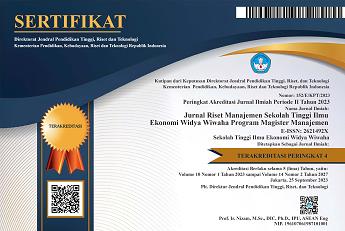AKSELERASI PROGRAM EDUKASI KEUANGAN MELALUI KOLABORASI BANK INDONESIA, LEMBAGA KEUANGAN, DAN PERGURUAN TINGGI
DOI:
https://doi.org/10.32477/jrm.v2i2.83Keywords:
literacy, education, financial inclutionAbstract
This study aims to investigate the possibility of acceleration of financial education programs in Indonesia, through the collaboration of the three main parties, namely: (1) the regulator (Central Bank/Financial Services Authority). (2) the practitioner (financial institutions); and (3) the academia (universities). The study employed a qualitative approach to assess the opinions of the stakeholders in the Gadjah Mada University and related financial practitioners regarding accelerated implementation of financial education programs in Indonesia, which involved interviews with 24 informants who were considered to have knowledge about the financial education program in Indonesia. The study concluded that the respondents showed a positive perception on the importance and benefits of financial education programs in Indonesia. Other findings depicted that financial education programs need to be directed at the entire community with a wider coverage range. To expedite the process, a solid collaboration needs to be made between the three main parties: (1) Central Bank/ Financial Services Authority as regulator. (2) financial institutions (practitioners and providers of financial products and services); and (3) academia (universities). In terms of the implementation of the proposed program, the collaboration of all three parties need to be directed to the selected students who will firstly be prepared to be a financial educator (by giving knowledge, education and mentoring). Selected and well-trained students are expected to be effective educator who has energy resource availability in large quantities and a more mobile and larger coverage to accelerate financial education program in Indonesia.
References
ACNielsen Research (2005). ANZ Survey of Adult Financial Literacy in Australia. Final Reseach Report, Melbourne.
Al-Tamimi, HH., dan Kalli, AB. (2009).Financial literacy and investment decisions of UAE investors.The Journal of Risk Finance 10; 500-516.
Apostoaie, M.C. (2010). Central Bank’s involvement in encouraging economic education and literacy. Economics and Applied Informatics, 26: 147-154.
Beal, D. dan Delpachitra, S. (2003). Financial literacy among Australian university students. Economic Papers 22: 65–78.
Bialaszewski, D., Pencek, T., dan Zietlow, J. (1993). Finance requirements and computer utilization at AACSB accredited schools. Financial Practice and Education: 133-139.
Bönte, W. dan Filipiak, U. (2012). Financial literacy, information flows, and caste affiliation: Empirical evidence from India. Journal of Banking & Finance 36: 3399–3414.
Chen, H. dan Volpe, R. (1998). An analysis of personal financial literacy among college students. Financial Services Review 7: 107- 128.
Danes, SM., dan Hira, TK. (1987). Money management knowledge of college students.The Journal of Student Financial Aid 17: 4-16.
Dikti. 2014. Daftar Perguruan Tinggi. Diakses dari: http://www.dikti.go.id/id/direktori-pt/ daftar-perguruan-tinggi-negeri/
Emory, D.R., Schindler, P.S. (2011). Business research methods.11th edition.McGraw Hill, International edition.
Fluch, M. (2007). Selected central bank’s economic and financial literacy programs. Monetary Policy and the Economy: 85-104.
Gnan, E., Silgoner, M. A. dan Weber, B. (2007). Economic and Financial Education: Concepts, Goals and Measurement. Monetary Policy & the Economy: 28-49.
Kompas (2014). Literasi keuangan: Ibu jadi pilar. Edisi 11 Agustus: 17.
Marriott, P. (2007). An analysis of first experience students’ financial awareness and attitude to debt in a post-1992 UK University. Higher Education Quarterly 61: 498– 519.
OECD (2005). Improving Financial Literacy: Analysis of issues and policies. OECD Research report 85: 108-129.
OECD (2012). Measuring Financial Literacy: Results of the OECD/International Network on Financial Education (INFE) Pilot Study, OECD Working Papers on Finance, Insurance and Private Pensions 15, OECD Publishing.
OJK (2013). Annual Report 2013: Towards integrated financial industry supervision. 1-216.
Remund DL. (2010). Financial literacy explicated: The case for a clearer definition in an increasingly complex economy. Journal of Consumer Affairs 44: 276–295.
Rosacker, KM, Ragothaman, S., dan Gillispie, M. (2009). Financial literacy of freshmen business school students. College Student Journal 43: 391-399.
Slavin, R.E. (2012). Educational Psychology: Theory and Practice. 10th-ed, Pearson Learning, New York.
Williams T. (2007). Empowerment of whom and for what? Financial literacy education and the new regulation of consumer financial services. Law & Policy 29: 226–256.
Wooldridge, J.M. (2010). Econometric Analysis of Cross Section and Panel Data.2nd edition, MIT Press, London.
World Bank (2010). Improving access to financial services in Indonesia. Research report: 1-202.
Xu, L dan Zia B. (2012). Financial literacy around the world: An overview of the evidence with practical suggestions for the way forward. The World Bank policy working paper. Diakses dari http://elibrary.worldbank.org / doi/pdf/10.1596/1813-9450-6107









